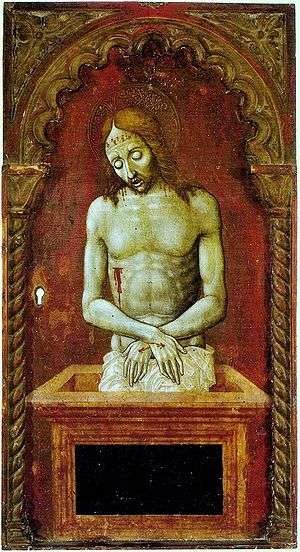Niccolò Alunno
Niccolò di Liberatore, known as L'Alunno (also Niccolò di Liberatore[1] and Niccolò da Foligno; the name is sometimes spelled Nicolò) (1430–1502) was an Italian painter of the Umbrian school.

Life and career
He was born at Foligno,[1] the son of an apothecary. He was a pupil of Bartolomeo di Tomaso; his master's assistant was Benozzo Gozzoli, the pupil of Fra Angelico. The simple Umbrian feeling in his work was somehow modified by this Florentine influence. His earliest known example (dated 1458) is in the Franciscan Church of Deruta, near Perugia. He painted banners for religious processions, as well as altarpieces and other pictures, died a rich man, and is supposed by Mariotti to have been the master of Perugino, Pinturicchio, and Andrea di Luigi.[1]

Vasari mistakenly attributed some of his works to Alunno di Foligno or l'Alunno,[1] misreading an inscription on the base of his large polyptych in the church of San Nicolò, where the painter signed himself “Alumnus Fulginiae” or “Nicholaus Alumnus Fulginiae”, which translates correctly as “Nicolò citizen of Foligno”.[2]
References
- Van Cleef, Augustus (1907). . In Herbermann, Charles (ed.). Catholic Encyclopedia. 1. New York: Robert Appleton Company.
- "Exhibition of his Work in Urbino". Archived from the original on 2006-12-09. Retrieved 2007-01-30.
Further reading
- Pope-Hennessy, John; Kanter, Laurence B. (1987). The Robert Lehman Collection I, Italian Paintings. New York, Princeton: The Metropolitan Museum of Art in association with Princeton University Press. ISBN 0870994794. (see index; plate 84)